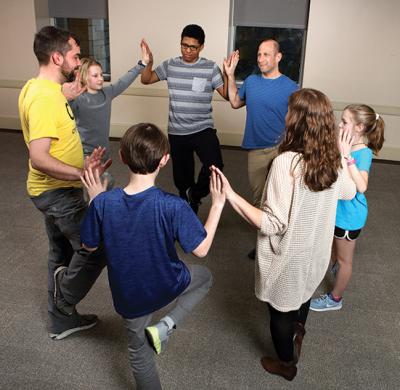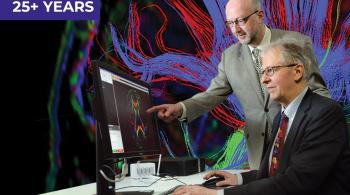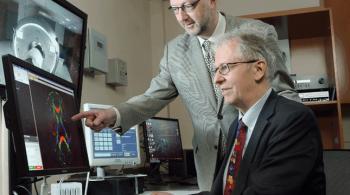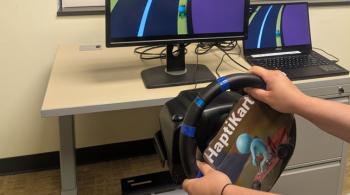 Eleven-year-old Atticus is waiting for his tai chi class to begin. He selects a large blue exercise ball—one with a handle—sits on it and deftly bounces around the room, his slight frame belying his boundless energy.
Eleven-year-old Atticus is waiting for his tai chi class to begin. He selects a large blue exercise ball—one with a handle—sits on it and deftly bounces around the room, his slight frame belying his boundless energy.
“It’s hard to get me tired,” Atticus says to his instructor, Dr. Dav J. Clark.
Atticus has attention deficit hyperactivity disorder, known as ADHD, and is one of about 30 children participating in a three-year study at Kennedy Krieger Institute that looks at how an ancient movement and mindfulness-based practice can help children control ADHD symptoms like hyperactivity, impulsivity and inattention.
ADHD is the most common behavioral diagnosis among children in the U.S., and it affects as many as 10 percent of children around the world. Children with ADHD often suffer from poor academic achievement due to difficulties with motor and behavioral control. Untreated, they’re at a higher risk than their peers for developing a mental illness, substance abuse or criminal behavior in adulthood.
The personal and societal costs of ADHD are high. Each year in the U.S., ADHD-related spending—including healthcare, education, and income and productivity losses—totals $143 billion to $266 billion, according to a report published in the Journal of the American Academy of Child and Adolescent Psychiatry.
As part of the tai chi study, which is being led by Dr. Stewart Mostofsky, director of Kennedy Krieger’s Center for Neurodevelopmental and Imaging Research, small groups of children with ADHD attend tai chi classes twice a week for eight weeks with Dr. Clark, a Kennedy Krieger research scientist and neuroscientist as well as a tai chi practitioner and teacher of mindful movement.
Dr. Mostofsky sees ADHD as a brain-based behavioral disorder. With the study, he’s looking to find out if engaging the sensorimotor system through movement- and mindfulness-based practice improves not only motor control but also behavioral control. Get the brain used to acting in a controlled way during tai chi, he theorizes, and the brain may be more likely to be able to control behavior outside the class, too.
Dr. Mostofsky received a grant from the National Institute of Mental Health to fund the study. He chose tai chi over other forms of movement- and mindfulness-based practice because it seemed like the best choice for children. Yoga, he figured, might be too strenuous for some of the children, and meditation too motionless.
A few studies have shown that tai chi can help adults with ADHD achieve some level of control over their actions and behavior, but this is the first significant study to look at tai chi’s effect on children with ADHD.
And because there is tremendous brain plasticity in childhood, which decreases in adolescence,” Dr. Clark adds, “practicing tai chi now could make a huge difference in these kids’ lives.
Many children with ADHD take medication to control their symptoms, but medication can come with side effects like tiredness, insomnia, stomach aches and changes in appetite. Movement- and mindfulness-based practices like tai chi may hold the key for those who want to reduce the amount of ADHD medication they’re taking, Dr. Mostofsky says.
For Atticus, who’s currently taking medication, “the goal is to get him to a point where he can say, ‘I think I can manage ADHD on my own,’ without medication,” says his mom, Tina, who enrolled her son in the study so they could learn more about alternative methods for treatment.
“Overall, the experience has been really great,” she says. Encouraged by improvements she noticed in her son over the course of the study, she enrolled him in therapy sessions and worked with his therapist to include tai chi in his treatment plan.
 Promising Results
Promising Results
Before the first class, Atticus and his fellow tai chi pupils each filled out a questionnaire asking them what they hoped to get out of the eight-week session. Most indicated they were optimistic that tai chi would help them control their behaviors and body movements.
“Some kids say they hope the tai chi will help them concentrate on their homework or just allow them to calm down a bit,” says research assistant Heather Thompson, who’s managing the study.
Because ADHD affects motor skills as well as behavior, each child also took a motor assessment before the first class, performing balancing, hopping and object-tossing exercises to demonstrate motor coordination and gross motor skills. Short exercises on a computer helped researchers assess the children’s attention and behavioral control.
At the end of the program, each child will complete another assessment of motor and behavioral control as well as questionnaires assessing ADHD behavior. In the post–tai chi motor assessments, Dr. Mostofsky, Dr. Clark and Thompson are looking for improvements in behavioral response control, attention, motor control and coordination. The kids’ parents also take post–tai chi questionnaires asking them about their children’s level of attentiveness, hyperactiveness, impulsivity and other behavioral features, such as mood.
So far, questionnaire responses have indicated that the tai chi classes help the children to be more cognizant of how they’re feeling and what they’re doing, and that they help improve the kids’ attentiveness, Thompson says.
Eight weeks is, of course, too short an amount of time to effect major change. “At this point, we are primarily seeing improvements in attention, with less improvement seen in hyperactivity and impulsivity,” Dr. Mostofsky cautions. “It could be that hyperactive and impulsive behavior will improve with a longer duration of intervention.”
Dr. Clark and Thompson give the children a tai chi DVD or—more recently—access to a video practice website. That allows them to continue practicing tai chi form and movement at home, when the eight weeks are up.
In the future, Dr. Mostofsky hopes to ramp up his team’s liaison with Baltimore City Public Schools—they’ve worked with three already—to study the effects of mindfulness programs on students in more detail. He’d also like to start up a mindfulness research classroom-laboratory at Kennedy Krieger that could allow for longer-term, ongoing mindfulness intervention studies.
Looking Ahead
Dr. Mostofsky hopes his study will help the ADHD community understand how tai chi and other mindfulness interventions can help reduce ADHD symptoms in children and help them become more aware of their behaviors and thoughts.
Ultimately, he would like to understand whether and how tai chi, and perhaps other movement- and mindfulness-based practices, could best be recommended to children with ADHD as a way for them to learn to control their symptoms while decreasing medication or perhaps even eliminating it completely. Tai chi could be a way to give children with ADHD a chance at an improved, perhaps even medication-free, life.
After completing this study, the next step, Dr Mostofsky says, is to see if the changes noted in the children who’ve taken the tai chi class are specific to tai chi, or if they’re also seen in children—either with or without ADHD—participating in more non-specific activities, such as dance or unguided physical recreation.
 Along with that, the goal is to study the effects—and the mechanisms in the brain through which those effects are produced—of movement-based mindfulness practice on children with other neurodevelopmental conditions, such as autism and Tourette’s syndrome.
Along with that, the goal is to study the effects—and the mechanisms in the brain through which those effects are produced—of movement-based mindfulness practice on children with other neurodevelopmental conditions, such as autism and Tourette’s syndrome.
At Kennedy Krieger, a team of experts on ADHD is working to better understand the causes of the disorder and to identify interventions that will help children with ADHD succeed in life.
Respect Hands
At the end of every tai chi class, Dr. Clark shows his students how to form their hands into the tai chi sign of respect for one’s opponent. Practitioners place the fist of one hand into the open palm of the other, a nod to the unity of opposites expressed in the “yin yang” concept.
I like making the ‘respect hands’ sign,” Dr. Clark says, “because what you’re really doing is respecting yourself.
For the children in his tai chi class, that means recognizing and respecting their own thoughts and actions and beginning to gain some control over their ADHD symptoms.
The children’s progress lets Dr. Mostofsky and his colleagues know that their research is changing lives, even as it happens.
For a full list of current ADHD research studies at Kennedy Krieger, please visit KennedyKrieger.org/ADHD.















